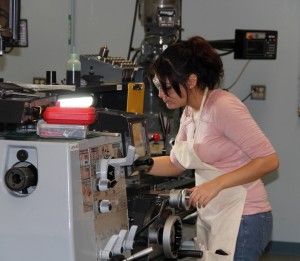As manufacturing employees age and retire, the gap between skilled workers and qualified replacements is catching up to the industry. A recent annual survey by the Manufacturing Alliance of Connecticut revealed hiring is one of manufacturing”™s biggest challenges.
“We have that problem and unfortunately every company I know has that problem,” Bill Manthey, CFO/vice president of Bridgeport Fittings Inc., an electrical parts manufacturer, said. “What happens if you can”™t find the skilled workers, you may not be able to take the jobs you might have.”
MAC conducted its third annual survey during the first quarter of 2015 by collecting opinion data from more than 200 manufacturers in the state. Manthey, also the president of the MAC Board of Directors, said the goal of the survey was to formally pool data so the state legislature can address industry needs and to inform the manufacturing community.
Other challenges reported include overhead costs like energy and electricity, but the inability to find skilled workers is a limitation that could keep companies from growing, Manthey said.
Kathy Saint, the fourth-generation co-owner of The Schwerdtle Stamp Co., a plastic design company in Bridgeport, said because companies outsourced and experienced economic downturns in the past few decades, they offered fewer apprenticeships. These factors caused the current gap in manufacturers, she said. Now that some are doing better, “We”™re in desperate need for those skilled workers,” she said.
Saint said she paid her toolmaker to stay past his retirement while she found a way to replace him, partly through other employees and outsourcing. She said this is common for manufacturing companies.
Saint said she hired a student with strong computer skills from Housatonic Community College”™s advanced manufacturing program in Bridgeport two years ago. She said she is sending him to classes and training him. In the past, workers would become full-fledged toolmakers over a number of years, but now companies are trying to expedite the process, she said.
Manthey said even though Bridgeport Fittings has an apprenticeship program, he often cannot fill immediate openings.
“Apprentices will solve problems a few years from now,” he said. “Between now and then it”™s going to be difficult because there”™s more demand for people with these skills.”
Manthey also attributed this lack of workers to a decline in manufacturing interest as a career. “There”™s still the image of the old kind of dirtier manufacturing I think that turns people off,” Manthey said. “That isn”™t the case now, but people don”™t realize that. They don”™t see the opportunities.”
Rich DuPont, interim director of the advanced manufacturing program, said it has been attracting more students since the program started in 2012. Still, he said people have a perception that manufacturing is no longer viable in Connecticut and that conditions are “dirty, dark and dangerous.”
“Manufacturing is much different today than even 10 years ago,” DuPont said. “It”™s high-tech, clean, safe and produces some of the highest paying wages and benefits out of any jobs available.”
Manthey said an apprentice can start with a salary around $35,000 and make up to $40,000. If someone continues and goes into management or engineering, he or she could earn $60,000 to $70,000. He said in the past few years, the state government has done a better job supporting manufacturing educational programs that promote careers in the industry.
The advanced manufacturing program is a response to the manufacturers”™ needs for skilled employees, DuPont said. The program is a partnership between the government and manufacturing companies who relay their hiring needs, he said.
In the one-year program, students learn about manufacturing skills like blueprint reading, machining and computer applications and receive a certificate, making them strong candidates for the 6,000 job openings statewide, DuPont said.
“If you”™re a graduate from one of these programs you”™re going to have a job,” DuPont said.
He said this year”™s advanced manufacturing program graduating class has 37 students, double last year”™s amount. He said they come from all walks of life, and the average age is 30. Of the graduates, seven of whom are women, more than half have already received jobs in the Bridgeport/New Haven area, and the rest are interviewing.
Graduates are going into apprenticeships for tool and dye, training for machinists, industry-focused computer operators and quality assurance technicians with wages that range from $14 to $20 an hour, he said.
DuPont said state programs like Step Up (Subsidized Training and Employment Program) and Ready to Work give companies the incentive and financial support to hire and train workers.
Randy Fescoe, manager of human resources at Lacey Manufacturing, a medical device manufacturer in Bridgeport, said one-third of his company”™s 30 toolmakers will be retired in the next five years. He said the company is training employees because it is so difficult to recruit from the outside. The company used state incentives to train apprentices and hire veterans and the long-term unemployed. Three Housatonic graduates are in the apprenticeship program, with one more joining in June.
“It”™s been a fantastic situation for us working with them,” Fescoe said. “They come out of there with the basic skills and understanding of manufacturing. They have a desire to be in manufacturing and they recognize there is career mobility.
















Comments 1